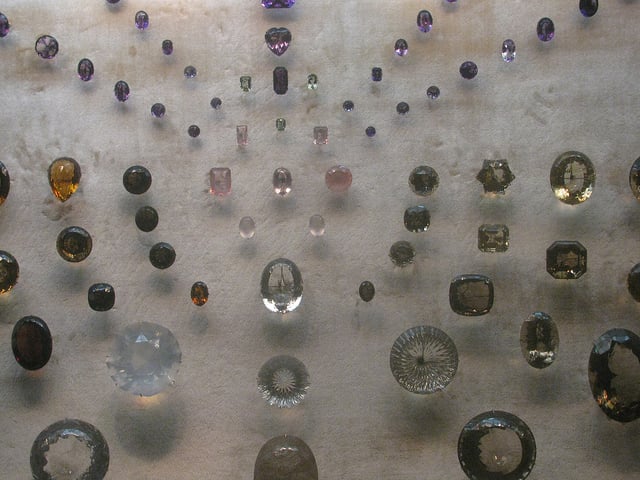How Rare is That Gem?
Rarity is one of the most prized qualities of gemstones. But some gems are far more rare than others! This article helps explain what's rare and what isnt.
3 Minute Read
Rarity is one of the most prized qualities of gemstones. However, it isn''t clear to people just how rare a given gem is. All of them are rare, but some are much more so than others.
The most common crystallized mineral is quartz. Even today, with the popularity of outside activities, few people have ever seen a crystal in nature. Those who have are mostly prospectors, miners and rock hounds who go to known collecting sites. All told the crystallized minerals that we consider gem materials make up a tiny fraction of 1% of the earth's substance.
Due to some excellent advertising, diamonds are believed to be the rarest of gemstones. One simple example will help put that into perspective: How many women do you know who don''t own at least one diamond? In nature diamonds are rare, but not so in the gem world.
Rubies and sapphires are different colored varieties of the mineral corundum. Now corundum is a fairly common mineral. Ranking a 9 on the Mohs scale of hardness (diamond is a 10), corundum has been mined extensively for abrasives. The emery on your emery boards and sand paper may contain corundum.
Gem-quality corundum is quite a bit rarer, consisting of only a percent or so of all the corundum found. The most common of the gem grade corundum is blue sapphire. Sapphire comes in every color of the rainbow and the other colors are rarer than the blues. This may be a bit of a surprise as the blue ones are so valuable. However, the law of supply and demand comes in here. Most of the people wanting a sapphire are looking for a deep blue gemstone, not something yellow or green. Hot pink sapphires and the pinkish orange variety know as padparasha do demand a high price in the market place. Generally though, it is the demand for blue gems that fuels the pricing here.
Ruby is the red variety of corundum. It is quite a bit rarer than the blue gems. The rarity combined with the demand for rich red gems keeps the price very high. Among rubies though, there is no shortage of small gems, the kind used in cluster rings. They are somewhat expensive, but readily available.
It is when you get into gems of a carat of more that they get really expensive. Good quality rubies in this size range are few and far between. The law of supply and demand is really obvious here. While many people would like a full carat ruby, few have the thousands of dollars needed to purchase one.
Hunderds of minerals have been cut as gems. Of these, some are considerably rarer than the popular gems. A good example is California''s state gem, benitoite. This is one of the better known of the rare gems, both because it is the state''s gem and because the notoriety the Gemological Institute of America has given it. They use it as an example in their classes of a beautiful and durable gem that will never have a significant impact on the market because of it's limited availability.
Gem-quality benitoite is only found in San Benito County, in Southern California. Just a few hundred carats are found each year. A lot of this, maybe even a majority, is kept in it's natural form. Very little gets cut and offered for sale.
Because it is fairly well known and quite beautiful, the larger pieces demand prices up to $5,000 per carat. This is quite a bit less than a diamond or ruby, but much more that other rare gems.
Some gems are even rarer than this. A few are so rare that only two or three examples are known to exist. One factor collectors take into consideration is the site the material came from. With this in mind, you have still more exceptionally rare gems. For example, peridot is a fairly common mineral that is found in several parts of the world, but gem-quality peridot is rare. Some peridot gems have very exotic origins: meteorites.
So how rare is your gem? Exceptionally rare, but maybe not as rare as others. Miners and prospectors, those people whose income is dependent of finding gem grade material, know the most likely places to look. Their welfare is dependent on it. However, no one else is ever likely to find a gem grade crystal in nature.
Curious about diamonds and how rare they really are? Check out this article!
Donald Clark, CSM IMG
Donald Clark, CSM founded the International Gem Society in 1998. Donald started in the gem and jewelry industry in 1976. He received his formal gemology training from the Gemological Institute of America (GIA) and the American Society of Gemcutters (ASG). The letters “CSM” after his name stood for Certified Supreme Master Gemcutter, a designation of Wykoff’s ASG which has often been referred to as the doctorate of gem cutting. The American Society of Gemcutters only had 54 people reach this level. Along with dozens of articles for leading trade magazines, Donald authored the book “Modern Faceting, the Easy Way.”
Related Articles
Negotiating Strategies for the Gem Trade
Insights on Gemstone Pricing
Appraising Pearls: How to Grade Pearls
Appraising Blue Sapphires
Latest Articles
Brazilianite Value, Price, and Jewelry Information
Ruby-Glass Composites vs Leaded Glass Clarity Enhancements
Morganite Buying Guide
How Do Amethysts Form?
Never Stop Learning
When you join the IGS community, you get trusted diamond & gemstone information when you need it.
Get Gemology Insights
Get started with the International Gem Society’s free guide to gemstone identification. Join our weekly newsletter & get a free copy of the Gem ID Checklist!
